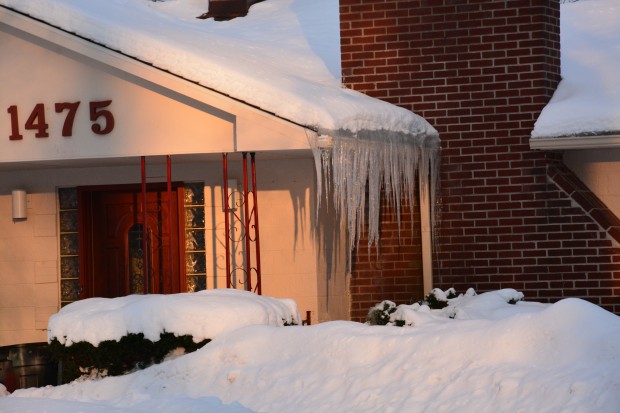Freezing is a state (presumably, a transitory state) to which I am reluctantly becoming accustomed. Freezing temperatures are the order of the day. Freezing-what is that, exactly? Water which is subjected to temperatures below 32 degrees transforms from a liquid state to a solid. We commonly call frozen water ice. We have ice just about everywhere. Icy is an adjective that describes relationships gone bad, cold color schemes, the mini stalactites hanging from my gutters, the surface of my driveway, my windshield, and just about every street surface between me and work. Icy means I need to dress in multiple layers-this takes a lot of time, and doesn’t always work so well. Well below zero ice means I need to cover my face, lest my eyelashes freeze. As I am a gardener, and not a scientist, I would define freezing as that state when the world more or less comes to an end.
 This section of the roof is always in shade, and the gutter stops up with little or no provocation. Snow fills the gutter, and when subjected to extreme cold, we have ice filled gutters. Once it overflows, icicles form. Understanding the process makes it no less aggravating. The lower part of the roof is laced with heat tape-no matter. The snow has been heavy, the freezing has been severe, and long standing.
This section of the roof is always in shade, and the gutter stops up with little or no provocation. Snow fills the gutter, and when subjected to extreme cold, we have ice filled gutters. Once it overflows, icicles form. Understanding the process makes it no less aggravating. The lower part of the roof is laced with heat tape-no matter. The snow has been heavy, the freezing has been severe, and long standing.
 Plants have a mechanism for dealing with freezing that is much more efficient than mine. Spring flowering hardy bulbs, for example, cannot be frozen through and through. The usual cause for the failure of potted spring bulbs is a complete freeze. The soil temperature is always higher than the air temperature. Soil which is insulated with a thick layer of snow is less likely to freeze deep.
Plants have a mechanism for dealing with freezing that is much more efficient than mine. Spring flowering hardy bulbs, for example, cannot be frozen through and through. The usual cause for the failure of potted spring bulbs is a complete freeze. The soil temperature is always higher than the air temperature. Soil which is insulated with a thick layer of snow is less likely to freeze deep.
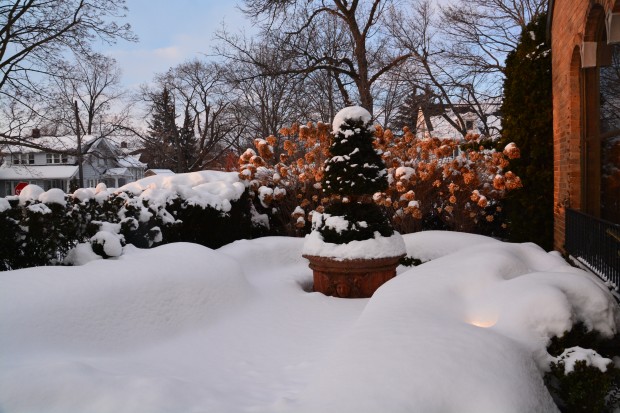 Cold winter temperatures trigger a biochemical response in the bulb, which converts the starch in the bulb to glucose (sugar). That glucose lowers the temperature at which the cells of the bulb will freeze. Salting a walk does just about the same thing. Salty water requires temperatures below freezing to freeze. The ice on my street is a result of air temperatures that have been so low that even the salty water and snow freezes solid.
Cold winter temperatures trigger a biochemical response in the bulb, which converts the starch in the bulb to glucose (sugar). That glucose lowers the temperature at which the cells of the bulb will freeze. Salting a walk does just about the same thing. Salty water requires temperatures below freezing to freeze. The ice on my street is a result of air temperatures that have been so low that even the salty water and snow freezes solid.
 Even small bulbs that are only planted a few inches below the soil surface are rarely bothered by extremely low temperatures. When they are completely frozen and rot, there is usually a lack of snow cover. The frost can penetrate the soil in Michigan as deep as 4 feet, but in a year with lots of snow, the frost is not near that deep. Down below the frost line, the soil is a uniform 55 degrees, year round.
Even small bulbs that are only planted a few inches below the soil surface are rarely bothered by extremely low temperatures. When they are completely frozen and rot, there is usually a lack of snow cover. The frost can penetrate the soil in Michigan as deep as 4 feet, but in a year with lots of snow, the frost is not near that deep. Down below the frost line, the soil is a uniform 55 degrees, year round.
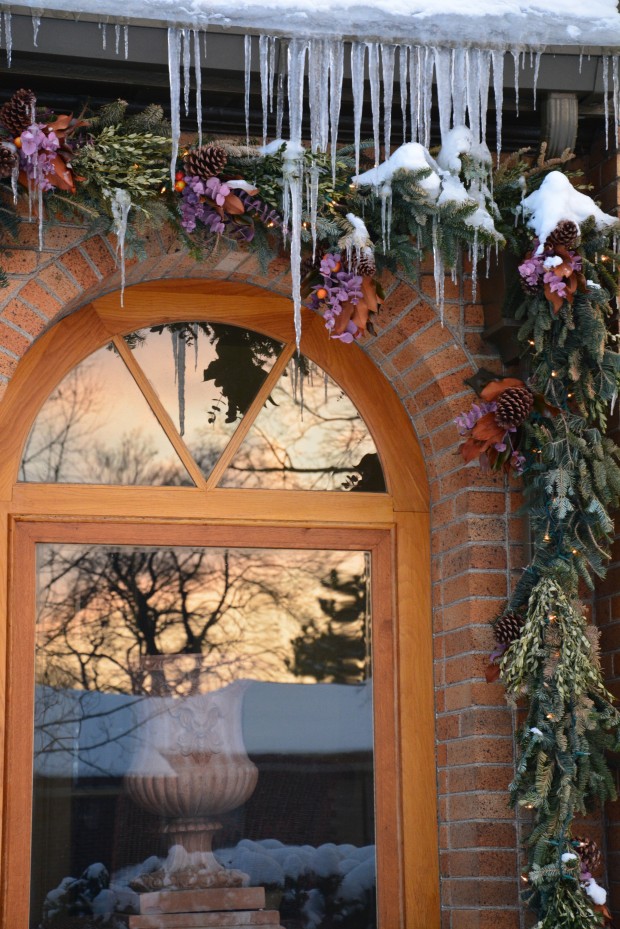 The technology exists to harness the ambient heat in the ground to heat cold buildings in the winter, and and cool hot buildings in the summer. Such a system transfers heat and cold, rather than producing it. 50 degree air on a below zero day is a lot of heat. 50 degree air on a 95 degree day is a lot of cooling. The upfront cost of such a system is considerable. I am sure someday that the technology will be simpler, and less expensive to install.
The technology exists to harness the ambient heat in the ground to heat cold buildings in the winter, and and cool hot buildings in the summer. Such a system transfers heat and cold, rather than producing it. 50 degree air on a below zero day is a lot of heat. 50 degree air on a 95 degree day is a lot of cooling. The upfront cost of such a system is considerable. I am sure someday that the technology will be simpler, and less expensive to install.
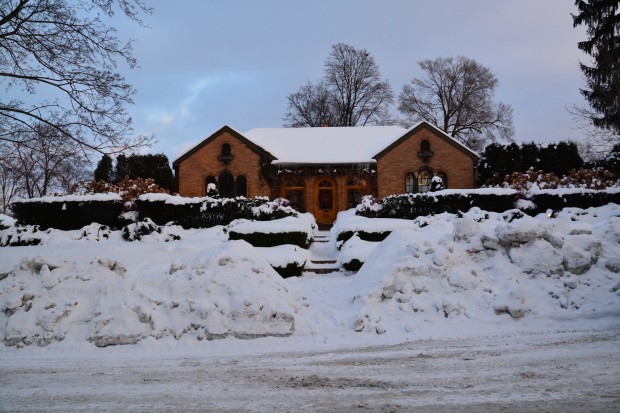 In the meantime, a 6 foot tall person walking down my sidewalk today would be completely hidden from view. This frozen snow will need warmer air temperatures to melt. A good bit of it will sublime, meaning it will pass from a solid to a gas without that intermediary melting stage.
In the meantime, a 6 foot tall person walking down my sidewalk today would be completely hidden from view. This frozen snow will need warmer air temperatures to melt. A good bit of it will sublime, meaning it will pass from a solid to a gas without that intermediary melting stage.
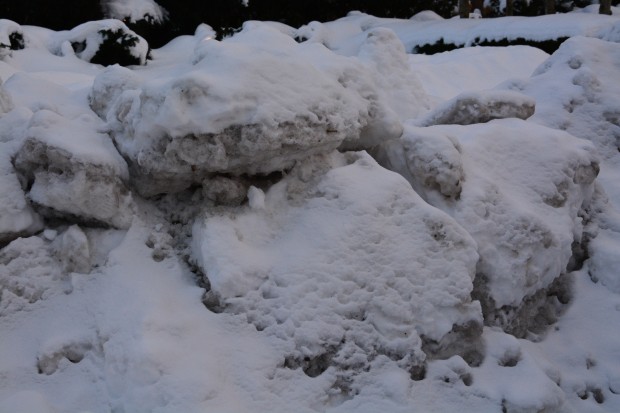 The snow plow did heave a lot of dirty frozen snow up over the curb. At least last night’s new snow freshened up the look.
The snow plow did heave a lot of dirty frozen snow up over the curb. At least last night’s new snow freshened up the look.
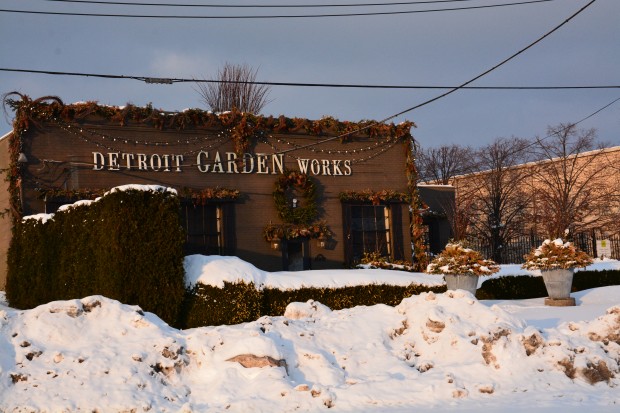 I am sure all of the tulips are safe and sound underneath our mountains of frozen snow. It’s February, through and through.
I am sure all of the tulips are safe and sound underneath our mountains of frozen snow. It’s February, through and through.
